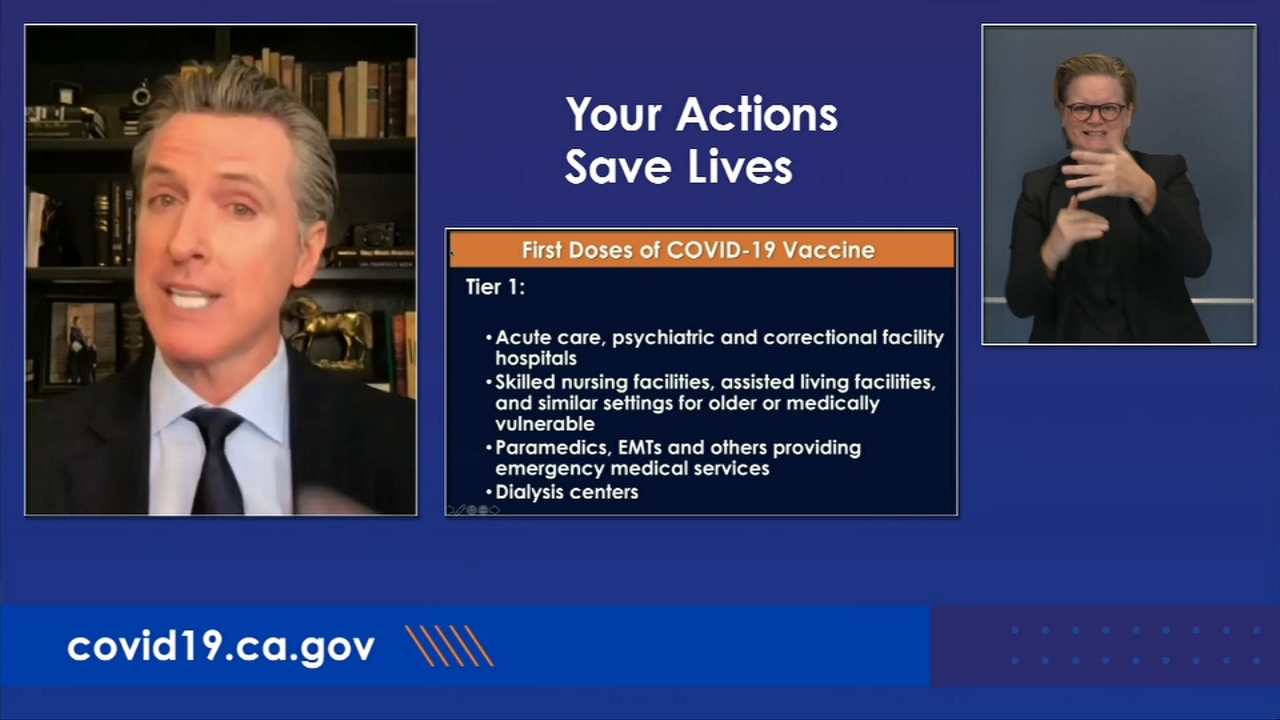Gov. Newsom announces new, regional stay-at-home order in California

SAN FRANCISCO -- Gov. Gavin Newsom announced a new, regional stay-at-home order Thursday as an "emergency brake" to curb the rampant spread of COVID-19 in California.
The state is being broken into five regions: Northern California, Greater Sacramento, Bay Area, San Joaquin Valley and Southern California. When the region's ICU hospital capacity falls below 15% capacity, the new stay-at-home order is triggered for a period of at least three weeks. (See below for where your county lands and its current ICU capacity.)
No regions are immediately affected, but current projections show all regions except the Bay Area meeting that dire threshold in the next few days. The Bay Area is currently projected to drop below 15% ICU capacity later this month.
When the stay-at-home order is triggered, bars, wineries, nail salons, hair salons and barbershops, and other personal care services will need to close. Private gatherings of any size will be prohibited.
Schools that have received a waiver to reopen can stay open, as can all "critical infrastructure."
RELATED: Vaccine distribution, misinformation has UC doctor worried
Restaurants can stay open for takeout and delivery, but they have to shut down both indoor and outdoor dining.
All retail stores are allowed to stay open at 20% capacity, unlike the last stay-at-home order in March. Newsom acknowledged the first stay-at-home order at the beginning of the pandemic unfairly advantaged some big box retailers, which were allowed to stay open. In this round of restrictions, Newsom said the state would be doing more to support small businesses.
Additionally, all non-essential travel is "temporarily restricted statewide," regardless of what zone you live in. Hotels and motels are now restricted to only guests traveling for an "essential" reason.
"This is the most challenging moment since the beginning of this pandemic," said the governor. "If there was ever any time to put aside your doubt, to put aside your skepticism, to put aside your cynicism to put aside your ideology, to put aside any consideration except this: Lives are in the balance. Lives will be lost unless we do more than we've ever done."
Here's how the state is broken down into five regions:
- Northern California, ICU capacity at 18.6%: Del Norte, Glenn, Humboldt, Lake, Lassen, Mendocino, Modoc, Shasta, Siskiyou, Tehama, Trinity
- Bay Area, ICU capacity at 25.4%: Alameda, Contra Costa, Marin, Monterey, Napa, San Francisco, San Mateo, Santa Clara, Santa Cruz, Solano, Sonoma
- Greater Sacramento, ICU capacity at 22%: Alpine, Amador, Butte, Colusa, El Dorado, Nevada, Placer, Plumas, Sacramento, Sierra, Sutter, Yolo, Yuba
- San Joaquin Valley, ICU capacity at 19.7%: Calaveras, Fresno, Kern, Kings, Madera, Mariposa, Merced, San Benito, San Joaquin, Stanislaus, Tulare, Tuolumne
- Southern California, ICU capacity at 20.6%: Imperial, Inyo, Los Angeles, Mono, Orange, Riverside, San Bernardino, San Diego, San Luis Obispo, Santa Barbara, Ventura
When it comes to enforcement, the state is largely leaving it to the local level. However, Newsom said there would be consequences for any uncooperative counties.
"If you're unwilling to adopt the protocols to support the mitigation and the reduction of the spread of this disease, we're happy to redirect those dollars to counties that feel differently," the governor said.
The state's biggest area of concern has been a rise in hospitalizations, particularly in ICU beds. California has broken its record for most hospitalizations five times in five days. As of Thursday, 8,831 people are hospitalized with the virus. The number of patients in the state's intensive care units also reached a new record Thursday: 2,066 people.
VIDEO: Gov. Newsom gives update on California's vaccine plan

"The bottom line is if we don't act now, our hospital system will be overwhelmed. If we don't act now, we'll continue to see the death rate climb, more lives lost."
The death toll has also spiked. On Nov. 2, the state saw 14 people killed by the virus, Newsom said. On Dec. 2, 113 people died of COVID-19.
There is widespread concern that the state is about to see an even larger surge in cases -- and eventually hospitalizations -- following the Thanksgiving holiday.
"The effects of Thanksgiving have not yet been felt," said Newsom. "Dr. Fauci I think said it best. He says we should anticipate 'a surge on top of a surge.'"
Newsom tried to end his remarks on a positive note, with an update on vaccines: "Help is on the way."
He gave more details on who would receive the first 327,000 doses of the coronavirus vaccine, broken into three tiers of priority:
- Tier 1: Acute care facilities, psychiatric facility hospitals, correctional facility hospitals, skilled nursing and assisted living facilities, paramedics, EMTs, emergency medical responders and dialysis centers
- Tier 2: Intermediate care facilities, home health care and community health care workers, public health field staff, primary care clinics, urgent care clinics and correctional facility clinics
- Tier 3: Specialty clinics, lab workers, dental clinics, pharmacy staff (especially in higher risk areas)
For a better experience, click here to view the full map in a new window










